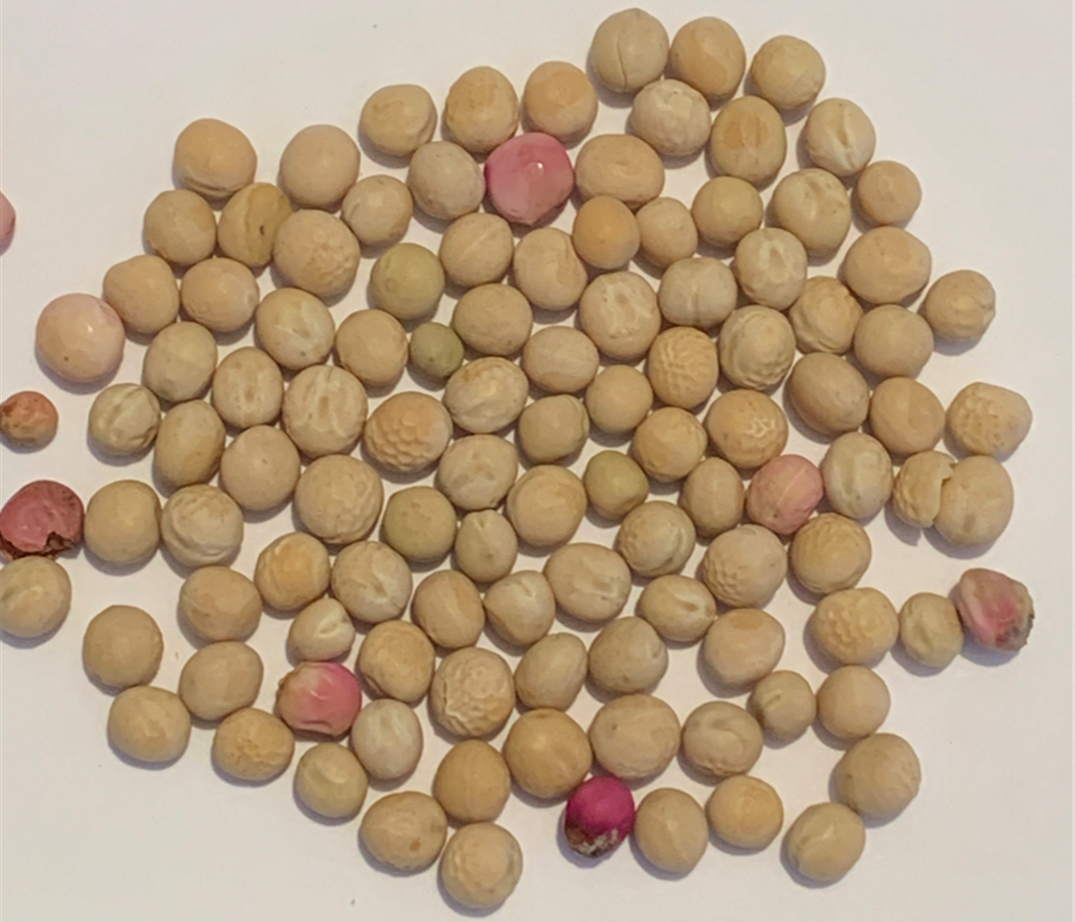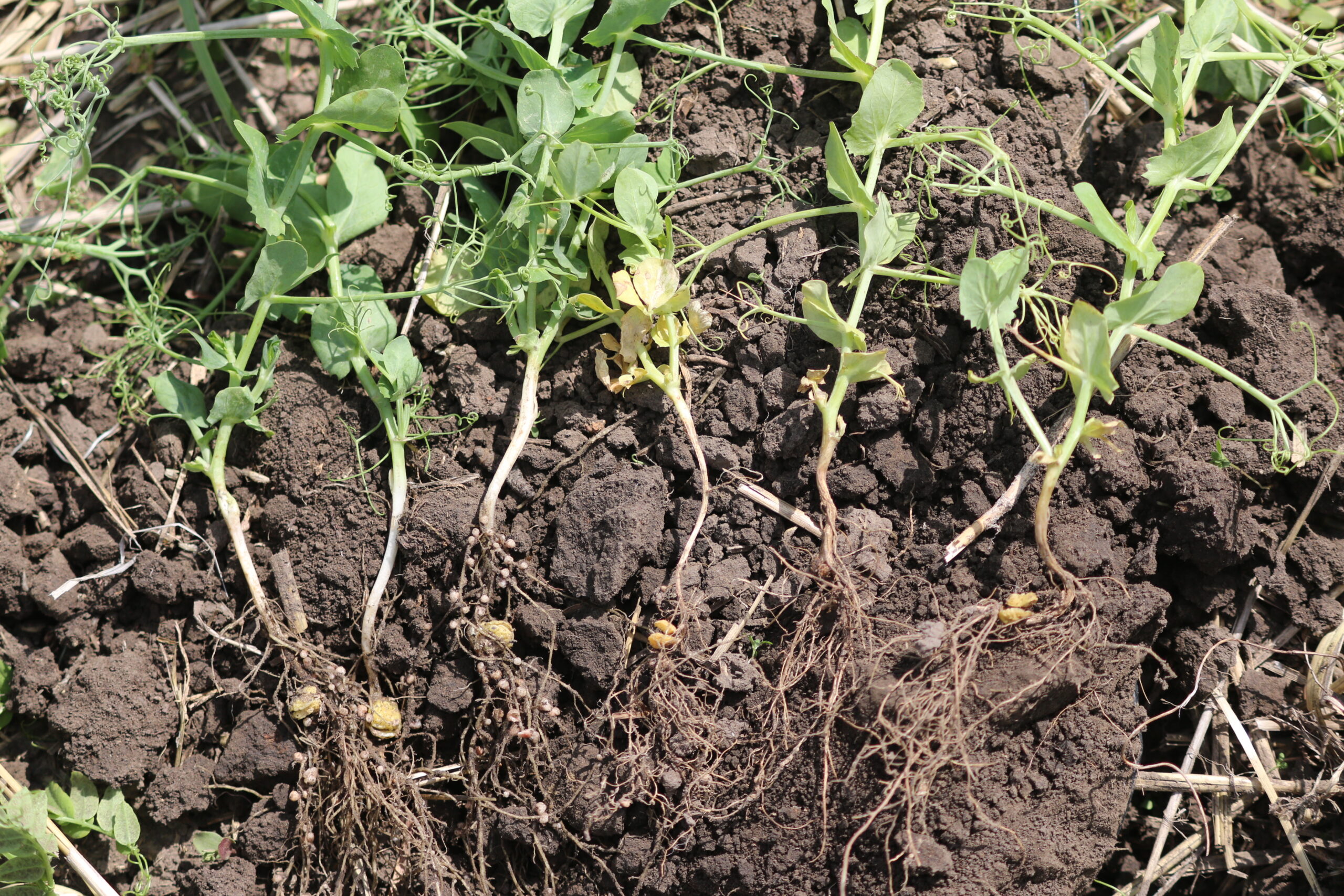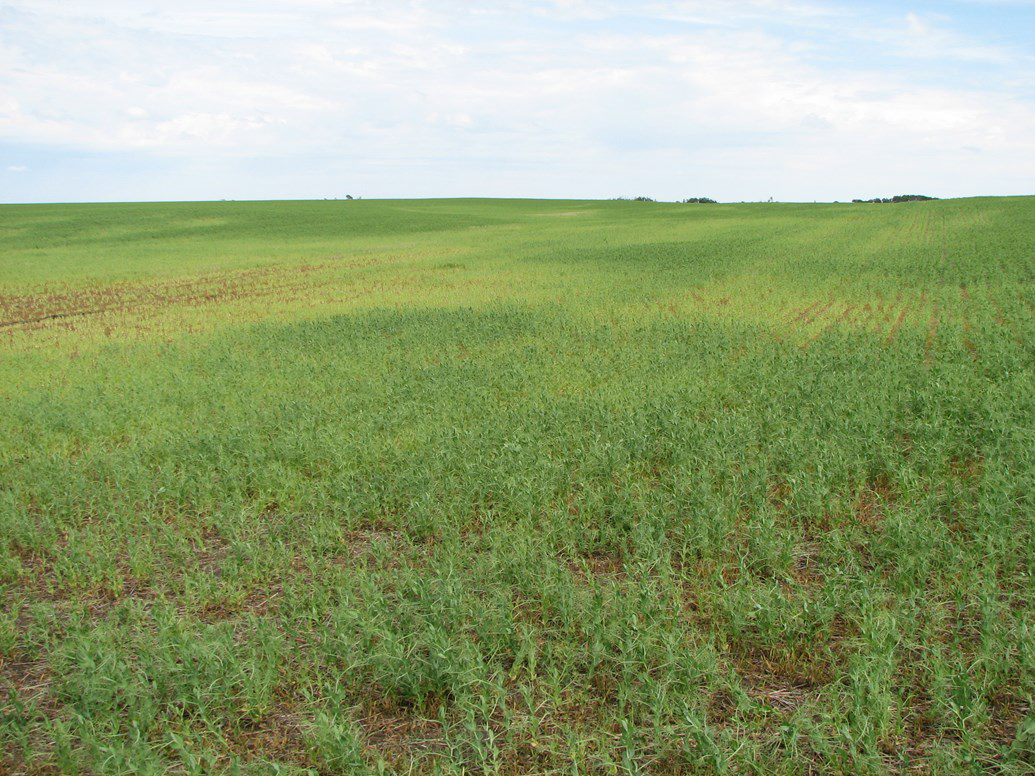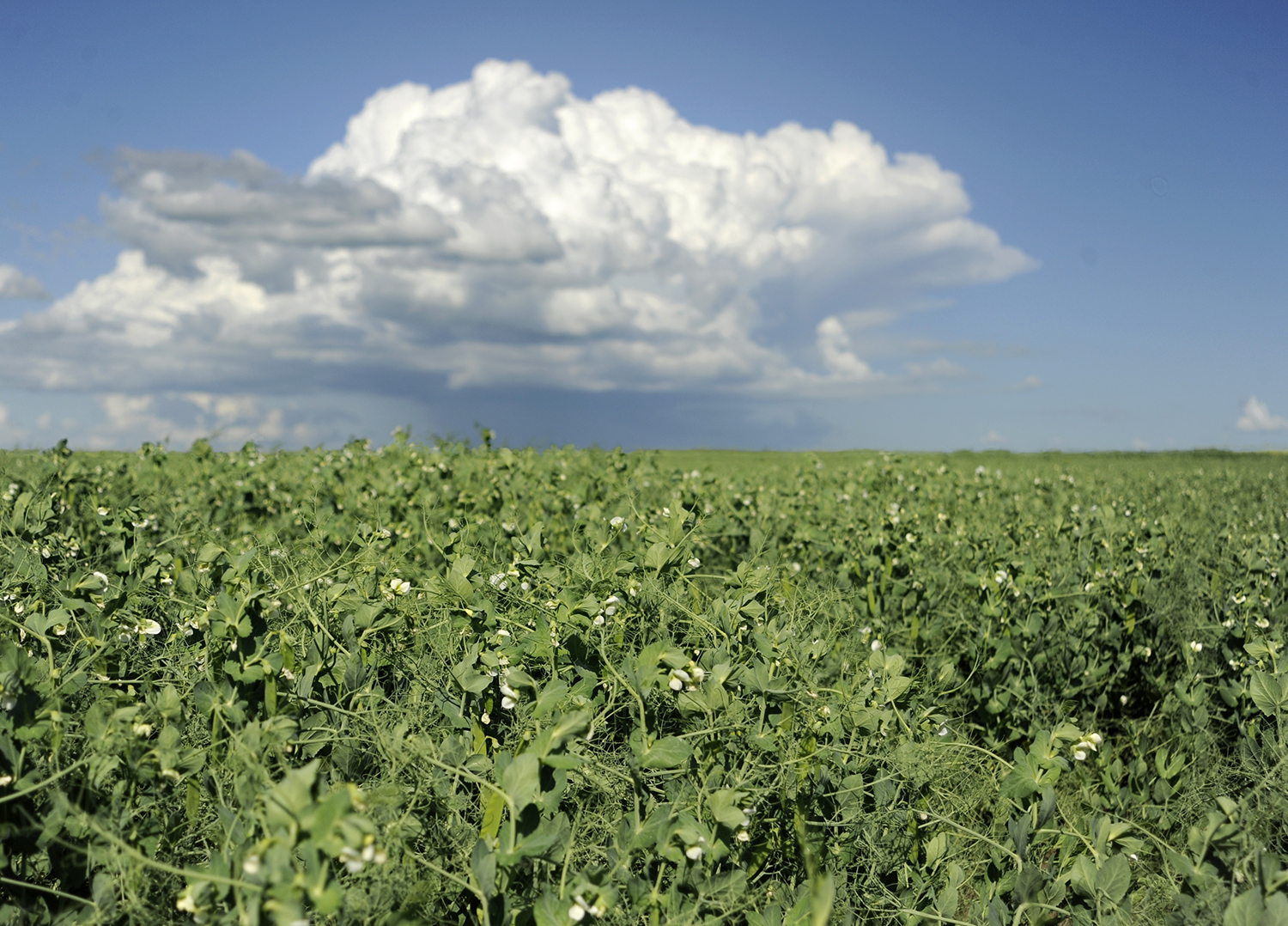Adapted from article by Bruce Barker, P.Ag.
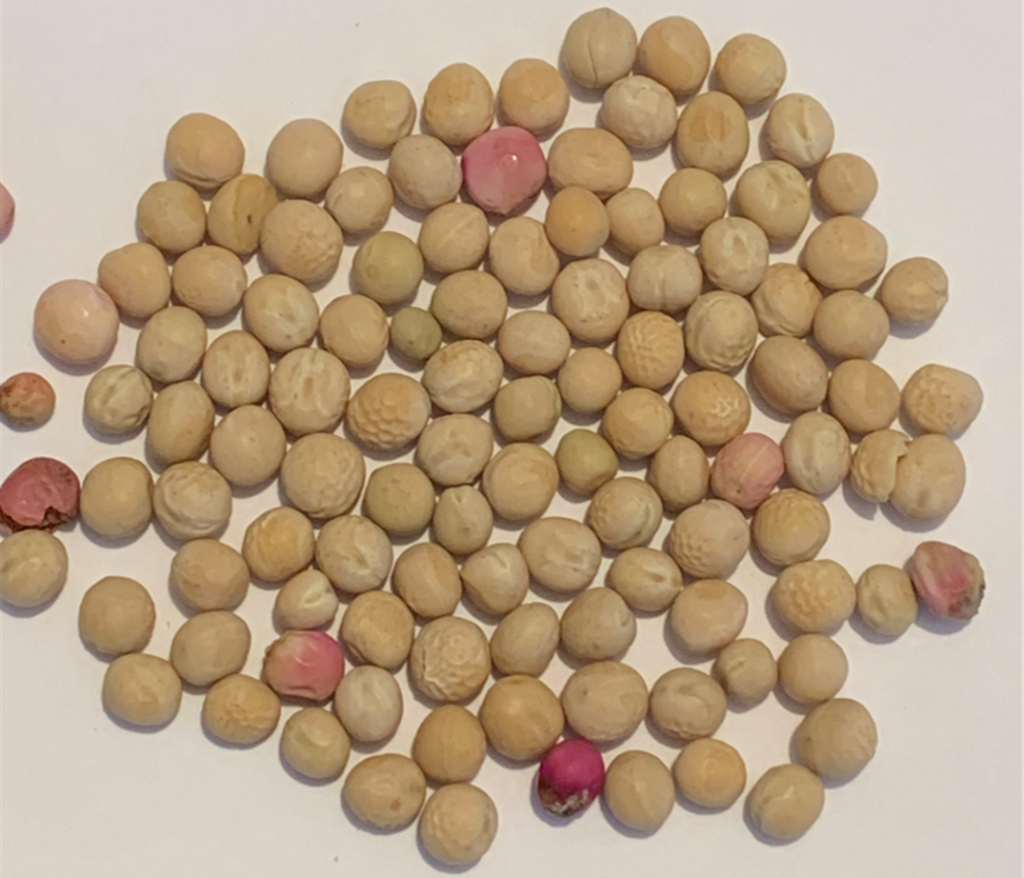
Pink seed in pea crops has been observed in isolated cases over the past few years. It is caused by Erwinia rhapontici, an opportunistic bacterial plant pathogen. The symptoms can be very striking with infected seeds become shriveled and turn an intense pink to red colour (Figure 1). The bright colouring can sometimes be confused with seed treatments. Unlike seed treatments, the pink colour does not wash off the seed. Yellow peas are most noticeable, because of the stark contrast in colours. Next noticeable are green peas and faba beans. Chickpeas, dry beans, and lentils can also be infected by Erwinia rhzpontici.
It was first identified in a samples of peas from a field in Southern Alberta in 1988 by Dr. Haung and associates. Since then it has been found across Western Canada.
Grading Factor
Pink peas are a grading factor in feed peas, and are included in either “damage” counts or “peas of other colours” (POC). The Canadian Grain Commission grading guide has 2% POC allowed in Number 2 Canada yellow peas and 1% in Number 2 Canada green peas. Overall colour is a factor when there are other damaged seeds, and total damage is usually the concern. In most cases, the peas end up as feed because of other damage in addition to the discoloured seeds.
Pathogen Biology
Erwinia rhapontici is one of the few bacterial species that cause a distinct pink seed (Figure 2). It also causes crown rot or soft rot on more than 15 species of plants. In the early 2000s Hung-Chang Huang and Scott Erickson with Agriculture and Agri-Food Canada (AAFC) in Alberta found that seven different strains of E. rhapontici caused infection on peas and beans, and that a strain from peas could infect kernels of durum wheat. Other research has found the pathogen can infect wheat, durum, rye, peas, beans, lentils, and chickpeas.
The pathogen can overwinter on seed and residue of infected crops even under Canadian Prairie winter conditions. Burial of infected residue to a depth of 6 centimetres does not reduce survival (Huang et al 2003).
Planting infected seeds can result in infection of the seedling and lower parts of the plant such as roots and basal stems. However, there is no evidence that is spreads further upward to the seeds produced by those infected plants (Hsieh and Haughn, 2010). The movement of the pathogen from plant to plant is not clear, but could possibly include transfer by rainfall or insect vectors.
Planting infected seed does not directly cause higher incidence of pink seed, but it could introduce the pathogen into a field as well as being a source of inoculum for pod infection. Therefore planting infected seed is not recommended.
As an opportunistic bacterial plant pathogen, E. Rhapontici usually infects the host plants through wounds caused by insect feeding (ex. aphids feeding), wind, or hail damage. Huang and Erickson found that damage during pod development stages of plant growth results in higher rate of seed infection.

Environment Impact
In addition to the presence of wounds, prolonged periods of high humidity are conducive to infection by E. rhapontici. Plant injury and a subsequent period of high moisture are major factors that predispose dry peas to development of pink seed disease – similar to conditions found after rain or hail storms.
Economic Impact
Infection can affect seed yield and seed quality. Haughn and Erickson conducted a field study at Lethbridge, Alberta in 2000 to 2002. They found that planting infected seed resulted in an average of 33%reduction in plant emergence and 44% reduction in seedling vigour (height), compared to the healthy control plants. Seed size can also be affected with a 19% reduction in thousand kernel weight found in their study. Over the three years of the study the average yield reduction was 44% but ranged from 36-49% compared to the healthy plants.
Pink grain is not visually appealing and can be confused with use of seed treatments. Buyers may be reluctant to purchase grain that is infected, depending on the target market.
Control Measures
The use of seed free from E. rhapontici infection is a recommended practice, as the pathogen can be seed-borne. Fungicidal seed treatments are not effective as the pathogen is a bacteria rather than a fungal pathogen.
Use of biocontrol agents such as Pseudomonas sp. and Bacillus subtilis has shown some promise in research projects against E. rhapontici species, but no products have been registered for this use in Canada.
Controlling insect pests may be important in reducing the spread of this disease especially during pod development stages. Little information is available on this strategy and it should only be considered in combination with insect populations reaching the economic threshold levels for the crop.
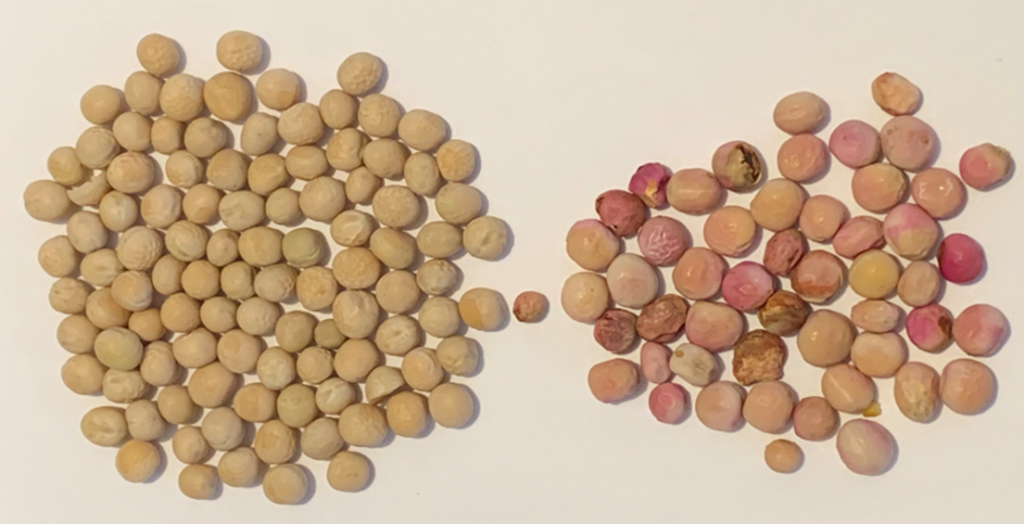
The wide range of host plants suggests that crop rotation between cereals and pulse crops may not be an effective method for control given that the pathogen infects most pulse and cereal crops grown on the Prairies. Further research is needed to understand the host range and survival mechanisms of E. rhapontici before crop rotation could be used in cultural control practices.
Given the sporadic occurrence of the disease and the association with infection after hail storms or insect feeding, the best practice that a grower can currently implement is to use infection-free seed, and then hope insects nor hail come along to aid infection.
Key Points
- Seed infection is associated with damage to pods such as hail, wind, or insect feeding, followed by high humidity.
- Peas, beans, lentils, chickpeas, faba beans, wheat, durum, and many other crops are susceptible.
- Infection can result in a lower grade as well as losses in yield and seed size.
- Do not plant infected seed to reduce the potential source of inoculum.
- Seed treatments or foliar fungicide applications do not control this pathogen as it is a bacteria.
References
- Huang, E.c., T.F. Hsieh, and R.S. Erickson. 2003. Biology and Epidemioligy of Erwinia rhapontici, causual agent of pink seed and crown rot of plants. Plant Pathology Bulletin. 12:69-76.
- Huang, H. C., & Erickson, R. S. (2003). Overwintering of Erwinia rhapontici, causal agent of pink seed of pea, on the Canadian prairies. Plant Pathology Bulletin, 12, 133– 136.
- Huang, H. C., Erickson, R. S., Yanke, L. J., Hsieh, T. F., and Morrall, R.A.A. 2003. First report of pink seed of lentil and chickpea caused by Erwinia rhapontici in Canada. Plant Dis. 87:1398.
- Huang, H.C, R.S. Erickson. 2004. Impact of pink seed of pea caused by Erwinia rhapontici in Canada. Plant Pathology Bulletin. 13:261-266.
- Huang, H.C., L.M. Phillippe, and R.C. Phillippe. 1990. Pink seed of pea: A new disease caused by Erinia rhapontici. C. J. Plant Physiol. 12:445-448.
- Hsieh, T.F. and H.C. Huang. 2010. Spread of seed-borne Erwinia rhapontici in bean, pea and wheat. Eur. J. Plant Pathol. 127: 579-584.
